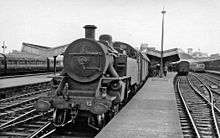NCC Class WT
|
Preserved No. 4 at Mallow in May 2006 | |||||||||||||||||||||||||||||||||||||||||||||||||||||||||||
| |||||||||||||||||||||||||||||||||||||||||||||||||||||||||||
| |||||||||||||||||||||||||||||||||||||||||||||||||||||||||||
| |||||||||||||||||||||||||||||||||||||||||||||||||||||||||||
| |||||||||||||||||||||||||||||||||||||||||||||||||||||||||||
The NCC Class WT is a class of 2-6-4T steam locomotives built by the Northern Counties Committee's parent company, the London, Midland and Scottish Railway for service in Northern Ireland.
History

18 Class WT locomotives were built at Derby Works in England to the design of George Ivatt between 1946 and 1950. They were numbered 1–10 and 50–57. They were a tank engine version of the NCC Class W moguls. A tank engine did not require turning at termini and the LMS had produced a series of successful 2-6-4Ts. Like the LMS Fairburn 2-6-4T built at the same time, they had a hopper bunker and absence of plating ahead of the cylinders. They were based on the LMS Fowler 2-6-4T by Sir Henry Fowler.
In December 1962 locomotive No.50 received a boiler from one of the ex-NCC 2-6-0 tender locomotives, the boiler and firebox being overhauled and repaired at Derby.
In early 1966 and towards the end of their careers, the Class WT locomotives were involved in working notable traffic. This was on spoil trains that transported fill for motorway construction from the Blue Circle cement works at Magheramorne to Greencastle near Belfast. Three trains of twenty hopper wagons each were made up, with a Class WT locomotive at each end. Each train when filled carried 600 long tons (610 t; 670 short tons) of rock and in all, some 7,600 trains had carried 4,250,000 long tons (4,320,000 t; 4,760,000 short tons) of material by the time the contract ended in May 1970.
The last of the Class WT locomotives were officially withdrawn in 1971 the last time one was in traffic being 22 October 1970. This made them the last steam locomotives in mainline operation in the British Isles; Córas Iompair Éireann steam in the Republic of Ireland having ended in 1962 and British Railways steam in Great Britain having finished in 1968,
One of these locomotives, No.4, has been preserved by the Railway Preservation Society of Ireland which operates it on special mainline trains. It is currently operational after an overhaul was completed in June 2015.
The RPSI is also looking at the possibility of building a new member of the class (No.58) to give them a second mainline tank locomotive considering the low availability of turntables on modern day lines.[1]
"Stopped" (date last used) dates for WT class. Although all officially passed to NIR those marked @ never worked for that company
1 27.08.66 @ 10 10.10.69 2 19.06.65 @ 50 25.01.70 3 18.03.69 51 16.10.70 4 22.10.70 52 12.01.66 @ 5 00.04.70 53 02.05.70 6 23.04.70 54 04.04.67 @ 7 00.04.65 @ 55 28.03.70 8 12.10.65 @ 56 29.04.69 9 01.02.67 @ 57 27.08.66 @
Technical details
The locomotives were built with many LMS standard features such as a self-cleaning smokebox, rocking firegrate, self-emptying ashpan, side window cab and a simplified footplate together with others which followed NCC practice, such as a water top-feed on a parallel boiler (as opposed to the taper boilers being used by the LMS at the time), Dreadnought type vacuum brake gear, Detroit sight feed cylinder lubricator and a cast number plate.
References
- ↑ RPSI Newsletter June 2010.
- Arnold, R.M. (1973). NCC Saga. Newton Abbot: David & Charles. ISBN 0-7153-5644-5.
- Currie, J.R.L. (1974). The Northern Counties Railway, Volume 2: 1903-1972. Newton Abbot: David & Charles. ISBN 0-7153-6530-4.
- London Midland and Scottish Railway (Northern Counties Committee). Class WT general arrangement drawing. Belfast: LMS (NCC).
External links
| Wikimedia Commons has media related to NCC Class WT. |